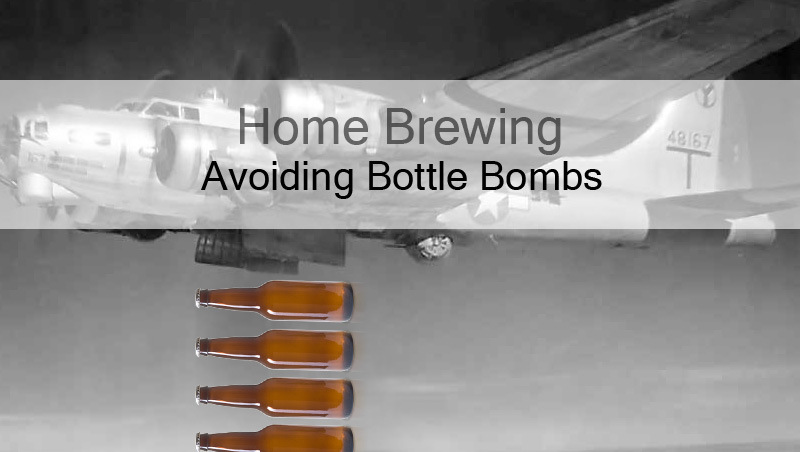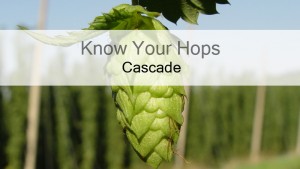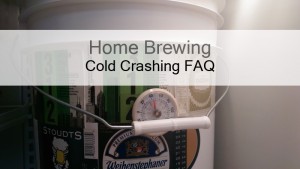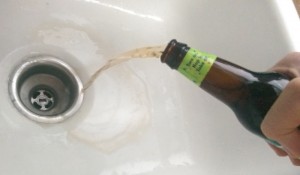
So you just bottled some home brew beer, you patiently wait the weeks away for the perfect time to try one out and when you go to put a few in the fridge you notice the evidence. The smell, glass shards everywhere, a huge mess.
Shit, you have bottle bombs!
What can be done to prevent this in the future? More importantly can I save the bottles that haven’t exploded yet? Bottle bombs suck and I don’t think I have to tell you why. The good news is they can be consistently avoided and in some cases may even be remedied before it is too late and your batch is wasted.
Bottle Bombs are created when the pressure from bottle carbonating home brew builds past the tolerance of the bottle. When it comes to home brewed beer, there are 6 common reasons why this could occur.
Too Much Priming Sugar
Pay careful attention that the amount of priming sugar you use and be sure it isn’t too much for your volume of beer. Giving the yeast too much sugar to process in the bottle is an easy way to end up with bottle bombs. If your not sure if you may have put too much priming sugar in your batch, Priming Calculators are a great resource.
Didn’t Mix the Priming Sugar Correctly
Another area where one can make bottle bombs is by not properly mixing the priming sugar after adding to the beer. If the sugar doesn’t mix well, it won’t be distributed evenly between the bottles. That can leave you with some beers that explode and some that stay pretty flat. Be sure to mix your priming sugar well without oxygenating it. If all else fails, Priming tabs, though a bit costly, make the process fool proof.
Your Home Brew Got Infected
The brewers arch nemesis, bacterial infection, is known to create bottle bombs as well. If you ended up with infected beer, take a good look at every link in the chain and make sure you are practicing the best sanitation methods at each step. Everything that comes in contact with the beer after the boil must be sanitized properly to avert this risk. Sorry but if infected, your beer is lost. Try to keep things positive and take this as an opportunity to learn from the mistake.
Your Wort Wasn’t Finished Fermenting
If beer gets bottled before it is finished fermenting bottle bombs are pretty much guaranteed to occur. Make use of a hydrometer and be sure you reach final gravity before bottling. Final gravity can be assured when specific gravity shows no changes for 3 or more days of measurement. If you don’t make use of a hydrometer, be sure that you give your beer more time to ferment than necessary to ensure it is actually finished completely.
You Added A Higher Attenuation Yeast
Adding a new yeast for bottle conditioning can be a great way to make subtle changes to your beer but be careful that the yeast doesn’t have a much higher attenuation rate than your primary yeast or you could end up kicking off more fermentation inside the bottle than you intended. Adding a different yeast may change the amount of priming sugar necessary for carbonation, creating a high pressure situation inside your bottles if not properly planned, dooming them to explode.
You Used The Wrong Bottles
If nothing else seems to fit your situation, take a look at the bottles you are using. Not all bottles are built the same. Beer bottles are designed to hold the pressures related to carbonated beer. Make sure the bottles you use are meant for beer and if reusing bottles be sure that the bottles are not meant for twist off caps and that the bottles are intended for reuse.
Ok, I Screwed Up, What Can I Do About It Now?
Maybe you’ve already had a few bottles explode and want to try to save the rest of the batch or your just worried that bottles bombs will likely be in your future. Whatever brought you here, the good news is that your beer may not be doomed, you can fight back and quite possibly save the batch.
Pasteurize
If your bottles are already exploding, it is too late to employ this method (though if your brave, you can release some gas as described below and give it a shot). Heating an already over pressurized glass bottle can create a dangerous situation.
If your beers are at the carbonation level you desire but fear the bottle may become over carbonated, if fermentation continues, a great method to use is stove top pasteurization. Essentially you just heat water to the point the yeast die and stick your bottles in the water long enough to kill them all off. This will stop all further fermentation from occurring. Stove Top Pasteurization
Release Gas
If your bottles use pry off caps, you can slightly open the cap to allow some of the gas to escape, then reseal. Do this a few times over the course of a few hours or days depending on how much extra carbonation you need to release. Unfortunately, it is going to be a bit of a guessing game. If you just have gushers, you can do this a few times over to let the beer settle down a bit before drinking as well.
Cold Crash
If you can get the yeast cold enough, they will flocculate, drop out of suspension and hibernate. This can be enough to stop the fermentation in your bottles and stop the pressure from increasing. If your beer is already over carbonated, release the gas first before doing this or you will have gushers.
Do you have any questions about bottle bombs? Ask away in the comments below and be sure to check the box to be notified of responses.








Hey Dan,
I took some fresh pressed cider, dumped it into a carboy and left it. Once it was done naturally fermenting I bottled.
I left it for 7 months and then opened it. The bottles either pushed the caps off or gushed out when I opened them. There was always a loud bang with the two bottles that I opened
I liked the final product and feel like I can work with it, but the gushing prevents that. Thoughts?
I’m convinced the “bottle bomb” with glass shards everywhere, is a myth. I’ve been brewing for 15 years now, got started with a 100 year old root beer recipe from the Fleischmann’s yeast company. Think about it, you have high gravity sugar water, and bread yeast – a yeast strain bred to put all its metabolic production into producing carbon dioxide, very little into alcohol. A matter of minutes after pitching the yeast in the root decoction/sugar water (and pretty quickly I altered the recipe to replace white sugar with brown sugar and molasses – lots of great nutrients for a yeast), I was bottling and leaving in the hot Texas sun to ferment. If ever there was a recipe for a bottle bomb, that would be it. Yet I never had a bottle explode. If I drank a batch within 2-3 weeks, it was fine, nice and fizzy with big head. Much after that, I’d get a geyser when I opened a bottle. As more time passed, bottles would start leaking from the caps. That’s the thing, the seal between the bottle and the crown cap is the weak link, it will fail and start releasing gas, then foam and liquid, before the bottle breaks. Another more recent example, I made a hard cider, and I wanted it to be sparkling, and have some sweetness to it. I back-sweetened it with brown sugar. I intended to pasteurize, but forgot about it for 2-3 weeks. When I remembered, I opened my test bottle (a liter bottle with a Grolsch-style closure, filled half full), and it forcefully popped and foamed up and out of the bottle. Intrepid soul that I am, I shrugged my shoulders and pasteurized anyway. I prewarmed the bottles, then put them in the hot water to pasteurize – again, a recipe for a bottle bomb if such a thing existed. Out of a dozen bottles, I only lost one, and it to the crown cap popping off, the bottle stayed perfectly intact, and this is a bottle I have used and pasteurized before.
i think the only bombs ive had are from where i bottled down too close to the sediment ( being the cheap bstrd that i am ) . that sediment is pure dormant yeast cells and should be avoided .